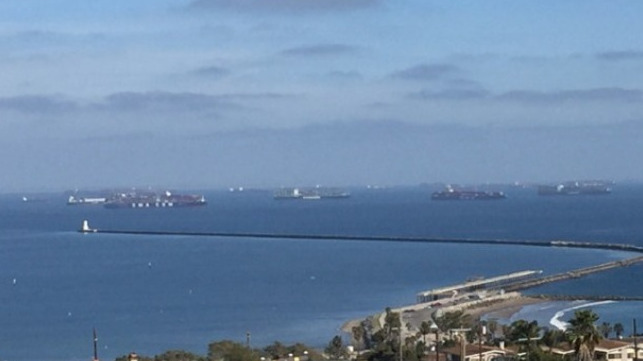Video: Containership Backlog in Southern California Sets More Records

Six weeks into 2021 and approaching the Lunar New Year holiday, which normally starts a slowdown in imports from Asia, the containership backlog at the Southern California ports is showing no signs of letting up. While the number of ships at anchor declined slightly, the number of ships on berth set a new record, and port officials are preparing for another wave of arrivals.
The U.S. Coast Guard recently released video of a flyover of the San Pedro Bay that gives a sense of just how congested the ports have become. Shot in late January, the area looks like a congested highway familiar to many of the world’s commuters.
Official U.S. Coast Guard video by Petty Officer 1st Class Richard Brahm
On February 8, the Marine Exchange of Southern California reported that the ports of Los Angeles and Long Beach had set a new record for the number of ships on berth. There was a total of 108 ships in the port, which had increased by two from the prior day. They reported a record total of 62 ships on berth of which 32 were containerships, which was also a new record for the port.
The number of containerships in the anchorage however was trending downward which the port officials took as a positive sign that the backlog was declining. At the beginning of the week, 30 boxships were still waiting for berths down from 40 the prior week. After having had to open up drift areas for the first time in 16 years a the end of January, the Marine Exchange reported that no ships were in the drift positions.
Despite the signs of progress, the Port of Los Angeles’s Signal port optimizer data is still recording an average of eight days in the anchorage for a containership waiting for space at the terminals. TEU volumes were also off slightly to just over 90,000 units moving through the Port of Los Angeles this week, but in a sign of the coming volumes, the port optimizer is projecting that volumes will jump back to between 160,000 and 170,000 TEUs for each of the next three weeks.
Reflecting the anticipated volume increases, the Marine Exchange reported yesterday that the anchorage was again full with 50 ships and that they had to again open the drift areas, places where the ships remain with power in effect circling waiting for an appropriate anchorage to become available. With 15 additional ships due to arrive today and only six due to move from the anchorage to the berth, the Marine Exchange reported that it needed several more drift areas to accommodate the increasing number of ships.
“We work with each ship and captain to agree on a good place to drift, we monitor them carefully and keep them 2 miles apart and away from shore,” they wrote in their update on volume in the San Pedro Bay.
Frustrated by the delays and lost productivity many of the shipping lines are searching for alternatives to keeping their ships waiting for long periods. A spokesperson for Hapag-Lloyd told a reporter at The Wall Street Journal that the line had canceled between 20 and 30 percent of its sailings into Southern California due to the delays, while CMA CGM announced it was altering the route on one of its lines substituting calls in Seattle and using Oakland, California as its terminal. Even this strategy has been backfiring as the shipping lines are reporting increasing backlogs and delays now at all of the major container terminal ports on the Pacific Coast.
The shipping lines have been compounding the problem adding what the ports call “extra loaders,” meaning additional ships beyond the scheduled runs which the lines are using to increase capacity and reduce the backlogs in Asia. While they might be helping in Asia, these boxships are increasing the number of ships jockeying for space at the West Coast terminals.
While there had been some hope that the backlogs might be easing, this week the National Retail Federation projected that imports of retail goods would continue to set monthly records at the major U.S. ports through at least mid-year meaning that shippers and carriers can expect the delays to continue and possibly worsen as 2021 progresses.
